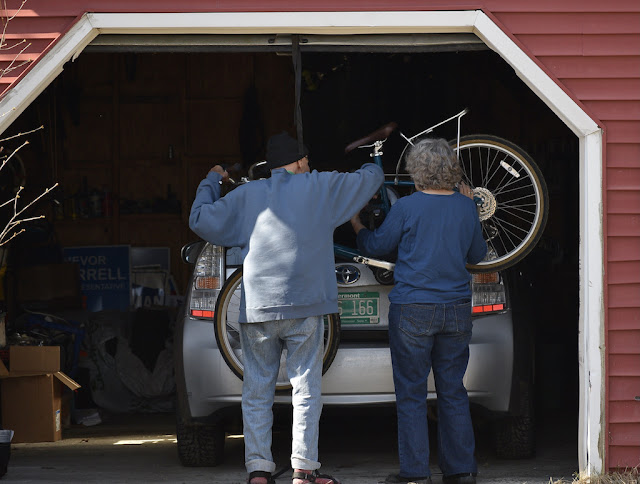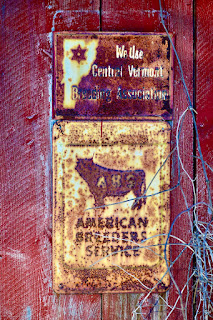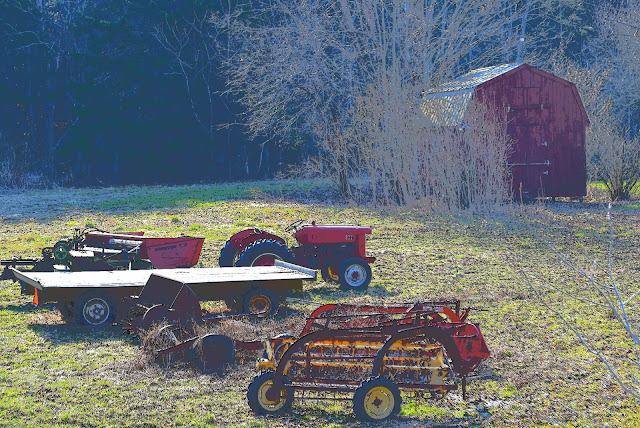Caution: Contains some (insect) sexual material and photos.
Wild Things Going On in Jericho, VT Backyards
Jericho, Vermont resident Bernie Paquette found COVID restrictions opened up a new world for him in his backyard. After spending hours and hours in his backyard throughout the spring and summer, from early morning to late evening, through careful close and curious observations he has uncovered a hereto before unknown impact to pollinators (brought about by the changing leisure behavior of people) that scientists are eager to learn more about. The implications for pollinators and other natural wildlife are disturbing and at the same time promising according to one State of Vermont Entomologist.
To better understand the significance of the startling finding and theory by Paquette, one must delve into the background of backyards, the life forms therein, and his observation techniques that led to this outstanding new threat and his innovative approach to address it.
Paquette realized more folks like him were seeking outdoor activities, traveling less, finding great pleasure in quiet, simple, close-to-home activities relating to nature, in their own backyards. They were mowing a smaller portion of their lawns, making them pathways to nature, and planting a greater percentage of native plants* to help improve habitat for pollinators. Not just perennials and vegetables, but also flowering shrubs and trees, to grow more forage and host plants that pollinators and other insects as well as birds are attracted to and utilize. Folks started or increased the size of their vegetable gardens. Many began mowing only paths winding around landscaped vegetation offering more time to enjoy an increasingly diverse and interesting landscape full of life full worth watching and interacting with.
Local nurseries were also realizing the surge of interest Jericho residents were giving to their backyards. Native plants and seeds sold out early in 2020 and sales are already brisk in 2021. Everything from vegetable seeds, vegetable starter plants, perennials, shrubs, and trees to local compost, soil, and lumber for raised beds are hot items being pre-ordered for spring of 2021. Tammy Davis of Davis Farm in Jericho, reports orders for their compost made from cow and chicken poop are as popular as the traditional chicken and cow products. Nate Ely, of Renaissance Building and Landscape, also reports a surge in demand for hauling Green Mountain compost. Christa and Mark of Jericho Settlers Farm report high demand for its popular starter organic vegetable plant CSA. Jane Sorensen a native pollinator plants and landscape design expert, UVM adjunct faculty lecturer, and co-proprietor of River Berry Farms Nursery in Fairfax, Vermont, reports strong organic pollinator plant sales as well as strong demand by the public for pollinator habitat-related educational opportunities.
Paquette believes that this new interest in their backyard the residents of Jericho are showing may lead to unintended consequences. Improved native plantings do appear to be drawing in more native wildlife to Jericho backyards. His early findings, though research is preliminary, show that these increased native plantings, some replacing sterile lawn area, are beginning to draw in and support greater diversity and quantity of butterflies, spectacular looking moths, colorful beneficial bugs, caterpillars dressed for show, and birds feeding those caterpillars to their young. Habitat loss has long been known as one of the causes of pollinator and beneficial insect decline. Home and landowners are perhaps nature's last hope for restoring habitat capable of supporting native wildlife and reducing habitat fragmentation.
However, with more folks staying home and having more free time (partly due to less mowing), a new threat to pollinators and other beneficial insects may be on the horizon or so Paquette theorized.
To set a baseline against which to measure his theory, Paquette walked about his backyard for 2 to 3 hours nearly every day from spring through early fall observing and photographing every insect, and most of the birds he observed. The process of photographing insects was in itself a trial and error learning process.
He first realized two methods of finding insects, sitting or standing in one spot, or walking slowly about the yard, each offered advantages and disadvantages. Setting in one spot bolstered his patience and sparked a realization that birders often discover. Birders typically walk through natural areas to seek views of birds, once sighting one, moving on for the next. Of late, a different approach penned ‘slow birding’ as in the Mills Riverside Park Sit Spot experience, is gaining a following by many birders as an alternative. In slow birding, one may not travel far if at all, perhaps only as far as your backyard. Then you spend perhaps an hour or more observing whatever birds come into view. Instead of a quick glance enough to ID any given bird, you spend more time watching the bird(s), observing details of plumage, bird song, and bird behavior as you become immersed at the moment.
The advantage of strolling very slowly about the yard, Paquette found, was that he became more familiar with not only the insects but also the plants and the symbiosis, the interaction between plant and insect species. Some insects are generalists while others only utilize specific species of plants for forage, and for a place to lay their larvae, to continue their progeny if you will. Finding plants with some of their leaves eaten or partially eaten by a caterpillar soon became a ‘good thing’ in Paquette’s viewpoint.
First, the caterpillars were finding a plant in his yard that they liked to eat, second, the caterpillars were of many colors and shapes that interested him, and third, more caterpillars meant more (next generation) delightful butterflies, moths, and well-fed baby birds.
And he found the balance in nature intriguing. Take oak trees for example. Oaks attract hundreds of caterpillar species. Those caterpillars eat a lot of oak leaves, yet the oak trees in Paquette’s yard seem unscathed. That is because oak trees have lots of leaves that do not get eaten, which is because oak trees have defense mechanisms and because many birds rely primarily on caterpillars to rear their young.
Either slow walking or staying in place Paquette determined he needed a customized picture-taking process that worked for him and the insects he desired to record. He started with both point and shoot and 35 mm digital cameras. Both offered at least a minimum of ability to record digital images of small insects that were visible to the naked eye. The 35 mm became his preferred unit. Experimentation with flash, with no flash, with various lenses, apertures, iso, and speed settings have led to incrementally better images. Macro photography, he noted, could be an option in the future if an affordable lens becomes available.
Paquette is quick to point out that equipment is the least important element in both recording observations and particularly in enjoying the observations of a myriad of incredibly fascinating array of life forms and their behavior seen only a few steps from his back door.
He posts the insect photos online on his Jericho Project on iNaturalist. iNaturalist is an online social network of people sharing biodiversity information to help each other learn about nature. It's also a crowdsourced species identification system and an organism occurrence recording tool. One need not know the name of an insect. All that is necessary is to post a photo and list the location. The system will give a good guess, in most cases, as to what the species is. In usually a short period of time, insect knowledgeable individuals will confirm or suggest a different Identification.
One particular behavior of pollinator and other beneficial insects in his backyard is what Paquette may be the first to uncover.
Jericho, Vermont is not unique in the world of natural propagation. One need not go any further than your backyard to experience nature going at it! From rabbits to dragonflies, from birds to bees, to flowers, and trees. They all do it.They all have sex. And yes they do it in your backyard. There is even sex blowing in the wind in spring as some trees and other wind-pollinated plants release their pollen grains and ovules. There are about 275 species of Vermont native and mostly solitary bees ‘assisting’ flowers matching and meeting up pollen from stamen to stigma; butterflies and even moths get in on the action as well as other species. Then, of course, the insects ‘do it’ themselves in backyards if there are plants that feed and host them nearby. This of course is not new to science. And up until the latest focus on their backyards by many residents (at least in Jericho), this all went about as it had for millennia.
What Paquette has discovered or at least theorized is related to how this new increased focus and time spent by folks in their backyards is impacting insect sex.From the time he was a small boy, Paquette was fascinated by the natural world nearby and within his childhood backyard; from tall grasses in which to make hideaway fortresses with flattened grass moats to pine needle laden forest floors to walk upon with bare feet, to streams, puddles and ponds full of aquatic and overflying life. He loved to imagine what the whole body of the many insects smooshed against car windshields (windshield phenomenon) and headlights, looked like before they got smooshed. Often sighted praying mantis would capture his attention and focus for hours if not days. Insects seemed to be everywhere back then he reminisces. One could hardly feel bored for lacking a play partner with all of the diverse and abundant life forms in his childhood backyard.
However, things are different now. Even in retirement, life moves fast. Distractions galore promise to entertain, yet leave a hollow wanting. The next best thing or things are always somewhere else. The reach, (is) never enough to capture the image and focus once attainable as a child by bending down and observing ants* scurrying about repairing a damaged ant mound. Now, nature is loopy from being pounded through 8 rounds in the boxing ring. We have pummeled her to extinction in some cases, and drastically reduced the quantity of many of those species that remain. Nature struggles to replicate herself due to many causes including habitat loss. Paquette believes we have lost much of what fired his curiosity, patience, empathy, love of life during his childhood. Fortunately, he believes, we can, every one of us, in our own backyards, help turn the tide on pollinator and beneficial insect demise. We can repair some of the damage. But we must be careful to do no more damage in the process.
*Many spring ephemeral flowers rely on ants to move their seeds about.
In our desire for aesthetic beauty, we have planted things that we are ‘told’ look appealing like monoculture alien grass for lawns, and alien plants that become invasive disrupting our native ecosystems, and flowering plants from Asia and Europe that do not feed our native wildlife.
Now that we are spending more quality time in our backyards, we are finding we need not chase the ‘next best thing’. Our backyards can give us the simple easy to access pleasures that truly fill our capacity for contentment, enjoyment, pleasure.
So what is the problem? More native plants, fewer alien plants, more butterflies, and native bees, more birds. More time in our backyards enjoying them. Great right?
Paquette theorizes based on his observations to date, that this new increased focus by folks into their backyards is impacting insect sex. “At first the insects didn’t seem to mind that I was taking photos of them having sex.
I mean, they didn’t stop, or pull the covers over themselves, or cry out some expletive shriek. And geez, they are not people, they are just insects. Or so I thought at first. As the days of observation went by, I started to notice a behavior change. By mid-summer insects in coitus contrary to my prior observations, were seldom seen out in the open. Yes, I was still finding bits of leaf and twigs jumping about on the ground and leaves moving about on windless days, even ripples of water in a pool followed by a massive emergence of bubbles.
 |
| Tricolored Bumblebee |
After much experimentation and additional observation, Paquette determined that the increased ‘interest’ in the insects was for the most part fine with them. Native bees did not sting, even after placing hands and camera inches from them thousands of times. Dragonflies still occasionally landed on his hand. Beetles still scurried about leaf litter underfoot. Orange newts waddled side to side over and across his feet before scampering away.
However, when it came to sex, they wanted some privacy! Or so their behavior seemed to be saying. This, Paquette surmised, was not good. More folks spending more time in their backyard, meant more unintentional or otherwise, unwanted disruptions or oversight of what had previously always been a private romantic affair out in the open. With many folks feeling the need for a ‘cleaned up’ raked yard, insects might not find enough ‘cover’ to get it on.
Not wishing for any barriers to their procreation instincts, Paquette came up with a potential solution, sort of a take-off of the ‘one-night stand motel’. He has built some prototype insect hotels using wood match stick boxes covered with candle wax to make them water repellant. However, this method failed. The challenge: how and where every insect species ‘do the deed’ appears to be unique! To this point, Paquette is frantically working to record (in photos) each species in the act of ‘romance’ before they all become too shy to perform in the public eye.
Scientists expressed intrigue with Paquette’s findings and theory and recommend the public enjoy all life forms in backyards whether it be observing insects feeding, flying, moving through various stages of their development and or having sex. Like snowflakes, each species is unique with intricate details that can capture the attention and wonder of all ages of backyard observers.
Happy April Fools’ Day; an aroma and taste of spring, serious thought, with a spicy finish of foolery and fun.
Remember to step out into your yard (often) and get to know your Nature Neighbors! Plant lots of Vermont Native perennials, shrubs, and trees then watch the show of life.
*Read the NY Times Opinion piece: We are a Nation of Immigrants. Our Ecosystems Shouldn't Be.
Bernie
PS If you are concerned about pollinators in Jericho and believe like me that we as individuals as well as a town can do more to improve the habitat for pollinators, send me a note. I have another pollinator project that I am working on that I can share with you.
























































